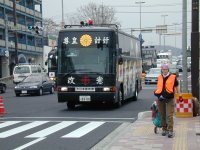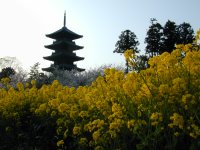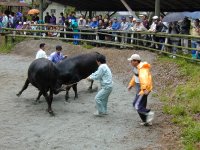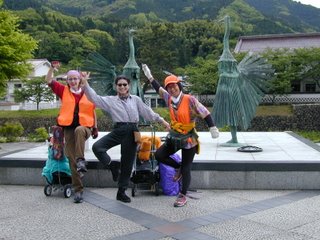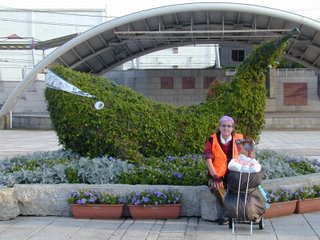READ BLOG FROM HOKKAIDO
TRY TO TRANSLATE THESE JAPANESE EMAILS HERE
*Please note that these emails first appeared on what was the original Japan on Foot web site, which was maintained by Etsuko during the course of the walk through Japan.*
From: Road Walker
Date: Wed Dec 5 17:28:09 2001
親不知
お久しぶりです。
ずいぶん進んでいてびっくりしました。
私も,親不知を通りましたが,
あのスノーシェルター(っていうんですね。初めて知りました)の歩道のない道には,
はっきり言って恐怖を覚えました。
抜けたときのホッとした気持ちは今でも覚えています。
では,ゆっくり,ゆっくり,頑張ってください。

From: きくち
Date: Sun Nov 25 00:39:30 2001
新潟県のセーブオン店長です
先日は、お立ちより頂き有難うございました。
ほんの少しの時間ですが、貴重な体験話有難うございました。
足の疲れ休みになりましたか?
名前も聞かず、名のらずですみませんでした。
目的の地に着かれるのは何時になられるか存じませんが、
私の実家は、酒屋を営んでおりますので、いつかお立ち寄りください。
その時は、おいしいお酒を、お出しいたします。
まだまだ続く長い道のり、お気をつけて!
又、時々ここを拝見させて頂きます。
新潟県三島郡和島村 菊地

From: 深沢/中野
Date: Wed Nov 14 15:43:51 2001
おなつかしゅうございます!!!
メアリーさん、島袋さん、お元気ですか!
だんだん寒くなってきたので風邪など引いていないか
と心配しています。
デジカメ日記の「月山へ行く道」のメアリ?さんの後
ろ姿に思わず「メアリーさ?ん!」と呼び掛けてし
まった私達です(髪が伸びて、なんだか違う人みた
い)。
東北は、おふたりの好きな日本酒と温泉の宝庫です
ね。楽しんでください!!!
東京への到着はいつごろになるんでしょうねえ? そ
の時にはぜひお会いしたいものです! きっと連絡し
てくださいね?!

From: Msa Minade
Date: Mon Nov 12 01:12:46 2001
こらから東北地方は、体に厳しいですね!
島袋さん・メアリーさんへ
この旅を北海道のスタートから拝見させて頂き、貴方たちから勇気とガッツを頂いています!
これからは、東北地方も雪が降り始めてますので御体を大切に旅を進めて下さい。

From: マユサ
Date: Wed Oct 31 09:12:11 2001
明日から11月・・・
島袋さん・メアリーさん おはようございます
秋田県を過ぎて山形県へ入っていたのですネ(^^)
マユサの方は、21日「第8回四万十川ウルトラマラソン」100キロの部走ってきました。
エメラルドグリーン色した「四万十川」綺麗でした・・・実際に見れて良かったです。
この自然をこれからも大事に残して欲しいなあ?と思いました。
寒くなってきたので、風邪などひかないよう身体に気をつけて歩いてください!!
秋田から応援してます(^_-)
http://www.amy.hi-ho.ne.jp/mayusa/

From: 甲16
Date: Sat Oct 20 00:49:02 2001
おひさ!
こ んにちは。阿寒湖のライダーズハウスでお会いした釣り人です。10000ヒットおめでとうございます。HPはちょくちょく遊びにきていたのですが、書き込 みするのを忘れてました。事故なども無く、お元気そうで何よりです。この時期の東北地方は雨が多いので、風邪などひかぬようお気をつけください。
私のHPにもぜひ遊びにきてください。偏ってますが…。
http://www5d.biglobe.ne.jp/~keenedge/

From: Kimoto
Date: Wed Oct 17 14:54:17 2001
また来てね!
木元(母)です。
家で採れた野菜や栗などあげたかったけど、荷物を多くさせたらいけないと思って、せっかくきてくれたのに何のおもてなしも出来ませんでした。
今度はゆっくり遊びに来てね!頑張ってね!!
http://www.hana.or.jp/~kimo

From: Kimoto
Date: Wed Oct 17 14:47:21 2001
がんばってね!p(^▽^)q
先ほど(10/17 お昼)立ち寄ってくれた、惣菜屋の木元(娘)です。HPをよく見せて頂きました!
こ れから先、この辺(秋田県内陸山沿い)あたりを歩くときには、本当に「熊出没注意」!!今年は例年以上に多いみたいなので十分注意して、何かあったらすぐ 近くの民家か警察に行って、安全を確保してくださいね!来店の際に教えてあげればよかった、とつくづく思いました(??;)あの時間帯は忙しかったもの で・・・
応援してます!頑張ってくださいね!!
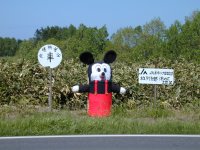
From: aon
Date: Mon Oct 15 17:42:18 2001
お久しぶりです。
ひさびさにホームページをみてみたら、なんと、10000番目の訪問者でした。なんか商品もらえる?
とにかくお元気そうで、なによりです。会社がなつかしくなったら、メール下さい。

From: かじび
Date: Mon Oct 15 09:43:16 2001
秋田の道もゆっくりと、楽しんで!
はじめまして!
先日のTVニュース&マユサさんのメールを見て、応援に来ました。
すごい壮大なチャレンジですね。感服しています。
昨日通られた阿仁の道は9月第4日曜に行われた
秋田内陸100キロチャレンジマラソンのコースでもあります。
お二人のチャレンジには足元にも及ばないかもしれないけど、
ボクも、マユサさんも参加しましたよ。
そして、マユサさんは見事完走されました。
ボクは力及びませんでしたが、秋田人情を満喫し、また来年の出場を心に決めました。
チャレンジ精神を持っていろんなことをしていきたいとも思ってます。
これから通られる横手市・山内村は僕の住んでいる増田町に近いので、
出来たら直接応援に行きたいと思ってます。
山内村を通る際は、ぜひ道の駅でイモノコ汁で力をつけてしていってください。
山内イモノコは日本一のおいしさだとボクは思います。
では事故やけがの無いよう、がんばってください。

From: マユサ
Date: Sun Oct 14 19:53:19 2001
クマに注意してネ!!
島袋さん、メアリーさん、こんばんは
今日、秋田県阿仁町の「道の駅」でお会いした
マユサ・・・熊谷@秋田です。
朝晩、冷え込むようになり霧が出るようになって来ました。山越えは、見通しも悪いので十分気をつけて歩いてください。私も日本全国マラソン大会で遠征してますので、またどこかでお会いしたいです。
頑張ってゴールを目指してください!!
マユサのHPアドレスは、下記です。
http://www.amy.hi-ho.ne.jp/mayusa/
_

From: Road Walker
Date: Fri Oct 12 13:24:45 2001
長い長い旅ですね。
久しぶりにHP訪れました。大館まで来たのですね。
私も徒歩縦断をしたときに大館を通りました。
その時に観光案内所で,偶然に新聞記者の人と出会い,
取材してもらって新聞に載ったことを思い出しました。
ジグザグに歩いているので,本当に長い旅ですね。
前回も書きましたが,ゆっくり頑張ってください。

From: くー
Date: Thu Sep 27 14:11:07 2001
はじめまして
はじめまして。北海道の情報を集めようと思ってHPめぐりをしていた所、こちらに辿りつきました。すごいチャレンジですね!私は現在青森市内に住んでおりますが、生まれたのは十和田市です。お二人も通られたようですね。
もう少し早くこちらのHPを知っていれば良かったなぁと思いました。これからも、たくさんの方と出会い、良い旅を続けて下さいね!

From: Road Walker
Date: Mon Sep 17 17:58:08 2001
ゆっくり,ゆっくり,頑張ってください。
初めまして。Road Walkerです。ずっと前から何度もこのページを訪れていたのですが,やっとメッセージを書く暇ができました。
私もずいぶん前になりますが,徒歩で日本を北から南まで歩いたことがあります。その時は,宗谷岬から沖縄の波照間島までほぼ最短距離を歩いたので,約100日余り,3250?の旅でした。
その苦労(?)を体験しているので,大回りをしながら歩くという行程に,ただただ感心し,驚くばかりです。今後とも体調に気をつけて,ゆっくり,ゆっくり,頑張ってください。
また,暇を見つけて見に来ます。よかったら,私のHP(できたばかり)も見に来てください。では。 http://plaza11.mbn.or.jp/~WalkerontheRoad/

From: 大庭 史榔
Date: Thu Sep 13 17:32:31 2001
お元気ですか?
島袋さん、お元気ですか?
あれからまだ数ヶ月しか経っていないんですね?
何か、日本中(世界中?)の話題になってるみたいですね?
ちょっとした旅行かと思っていたのに・・・
お身体に気を付けて頑張ってください!!!

From: 民宿鈴木
Date: Tue Sep 11 19:57:33 2001
雨にも負けず風にも負けず。
どうも。下風呂に来た時に泊まっていただきありがとうございました。無事に恐山を通過して良かったです。無事に通れるのか心配でした。台風が来て足場が悪いですが気を付けてこれからも良い旅を続けてください。

From: keiko
Date: Tue Sep 11 10:47:32 2001
今日の新聞で知りました。
はじめまして。
今日の新聞で、今青森県内を通過中、ということを知りました。大変そうだけれど、何だかうらやましいです。私も何時かトライして見たい、なんて思っています。
どんな道中記になるのか、楽しみにしています。
私はお2人が三沢に行く途中の町に住んでいます。お会いできるといいですね。(もしかした、らもう通過してしまったかしら?)
何はともあれ良い旅でありますように!

From: kapapa
Date: Fri Aug 31 23:30:19 2001
私も北海道へ
はじめまして!
私は名古屋で地理について学んでいる大学生です。
旅行好きが集まっている私のゼミでは、突然、○○へ行こうの会とういのがたびたび発足されます。
今回は、再来週にいきなり日本の最果て宗谷岬へ行こうという計画が持ち上がり、あわてて情報収集をしていたら、ここにたどりつきました。
今はどのあたりを歩いていらっしゃるのでしょうか。
私たちは道北を巡る予定です。
きっと歩く事で、ふとすると見逃してしまうような発見もなさっていることでしょうね。
私たちも単純な観光だけでなく、そこに暮らす人々の日常なぞ別の視点から見て、何か得られたらいいなと思います。
どうか、体調には十分気をつけて、よいたびを。

From: 木村真作
Date: Thu Aug 23 01:19:52 2001
今どの辺でしょうか?
島 袋さん&メアリーさんこんばんは。洞爺湖の大和旅館で一緒だった木村真作です。今どのあたりを歩いていらっしゃるのでしょうか?私はもう京都に帰ってまい りました。いま台風11号が接近していると思いますが、十分気をつけてください。またちょくちょくホームページもチェックさせてもらいます。それでわ!!

From: 黒木
Date: Fri Aug 17 19:54:14 2001
早くも3ヶ月過ぎたのですね
島袋さん、思ったより(もっとキョロキョロするかな?と思っていました)早いペースで旅行されているようですね!
日記を見ても良い旅のようで嬉しいです。
夏の暑い時期を北海道で、というのは賢い考えのようですね。
以前に話した那須の友達は5月?6月に53日かけて四国を歩き、照り返しも加わった暑さに閉口したそうです。彼らはいま単車でロシア横断中です。こちらも元気そう。
島袋さんとメアリーさんも、元気が一番!で、これからも楽しい旅を続けてくださいね♪
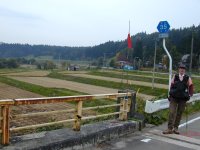
From: とき
Date: Fri Aug 17 17:40:33 2001
はじめまして。スタートしてからもう随分たつんですね。歩いて日本縦断なんてすごいですね。鳥肌たちました。今どこらへんに居るのでしょうか。わたしは写真をやっているのですが、是非お二人を撮りたいなと思いまして・・・
もし、会えたなら、写真を撮らせてください!!体に気をつけてがんばってくださいね!

From: フレーフレー
Date: Thu Aug 16 10:44:03 2001
身体には気をつけて
「やりたい」思ってもなかなか実現できないこと、ならば応援だけでもというのが今の私にできること。
旅、人の心を癒してくれる。そして人、言葉をかわし、様々な文化を吸収していける。
そんな経験をされているお二人の健康とこれからを祈って
乾杯!
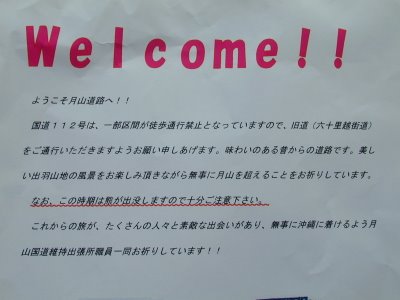
From: ドウエン
Date: Sat Aug 11 13:48:49 2001
良い旅、そして発見、出会いを!
メアリーさん、島袋さんはじめまして。
先日、日月火で横浜から宗谷岬までドライブをしてきました。
駆け抜けただけですので旅をした気分ではありませんが、まだ紫陽花が綺麗に咲いていることに驚いたり多くの新鮮がことがありました。
日本をめぐられる旅行記を楽しみにさせて頂きたいと思います。
お二方の旅が素晴らしい発見と出会いで満ちていることをお祈りします。

From: りょう&laure
Date: Wed Aug 1 21:42:46 2001
応援してまーす!
はじめまして!
意義のある大きな旅をしていて素晴らしいなと
思います。何もお手伝いできないけれども
ネットから応援していますね!
広大な北海道ももう少しですね?。
島袋さん(同郷で嬉しいです)、メアリーキングさん
頑張って!
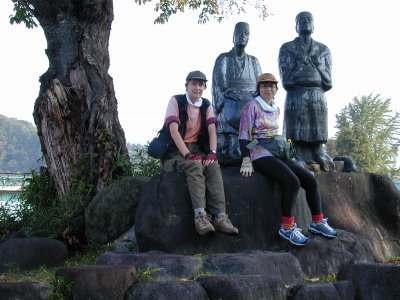
From: 智子
Date: Wed Jul 25 15:23:26 2001
とうとう峠を越えたのですね。
ちょっとホームページを見ない間に、峠を越えてしまったのですね。
体の調子はいかがですか。
あまりいい天気とはいえませんが、北海道の夏を楽しんでいってくださいね。

From: 渡辺
Date: Sat Jul 21 12:29:05 2001
ずいぶん南に来ましたね
メアリーさん、悦子さん、お元気ですか。
ずいぶん(北海道の)南まで来ましたね。
東京は、本当に暑くて暑くて、毎日サウナの中で暮らしているようです。でも、このウェブに来て、「大雪山」の文字を見たら少し涼しくなりました(ウソ)。
いつもフォト日記楽しみに見ています。食べ物の写真が結構あって、相変わらずグルメ^^;と言いましょうか、食い意地がはっていると言いましょうか、食べ物に対する好奇心は変わらないようで感心しました。しっかり食べて、元気に歩いてください。
そろそろ本州。暑いよ、本州は! 恐山は知りませんが、東北だってきっと暑いと思います。本州上陸^^;をお待ちしています。

From: 松下春樹
Date: Thu Jul 19 17:43:26 2001
夏風邪、夏ばてしないで
水分摂らず、体を良く拭き、シャワ?で汗を流そうとしなかったら心配いりません。
詳しくはメ?ルでおしらせしました。
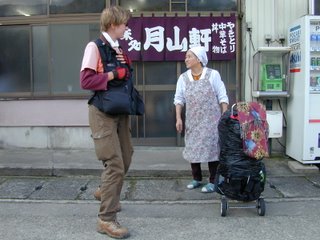
From:
Date: Thu Jul 12 22:29:56 2001
島袋さん、メアリーさん、お久しぶりです。
5月に礼文島でお会いしました利尻のバスガイドむらかみです。
久しぶりにのぞかせていただきました。もう、すっごく進んでいるので
びっくりしたところです。名寄のホーマックでご購入のカート、
これいいですよねえ。ワタシが北海道一周歩いた時も、
荷物の重さに耐えかねて、途中から島袋さんと同じスタイルになったので
なんか、笑っちゃいました。やっぱ、行きつくところはカートですね!
これからも、のんびりペースで進んで行ってください。
応援しています。
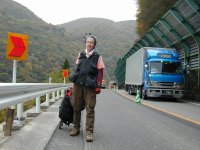
From: 優
Date: Fri Jul 6 23:41:10 2001
こんばんは
シマフクロウが幻想的で素敵ですね。
沢山の出会いと沢山の自然を満喫されて羨ましいです。
苦労も沢山あるのでしょうけどマイペースでガンバッテ。
日記がビルの谷間で暮らす身にしみる。楽しみにしています。

From: ユキト
Date: Fri Jun 29 23:15:07 2001
がんばって
今はどこまで進みましたか
天気にも恵まれてよいですね
これからもがんばって

From: 優
Date: Thu Jun 28 22:54:49 2001
元気に歩いてますか
最近、日記の更新がないので心配です。
いかがお過ごしでしょうか。
先は長いですゆっくり行きましょう。
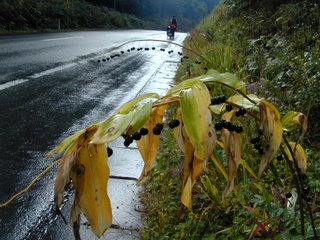
From: 河股智子
Date: Sun Jun 24 18:46:47 2001
懐かしいです。
悦子さん
相変わらず、お元気そうですね。中標津の父から悦子さんのことを聞き、ぜひ会いたいなあと思っています。私は今帯広に住んでますので、近くにお寄りの際は連絡ください。といっても、もう道東から離れてしまったかもしれませんね。
旅はまだまだ長いでしょうが、体に気をつけて頑張って下さいね。

From: KAZUKI
Date: Mon Jun 18 23:11:25 2001
お元気ですか?
悦子さん
お元気ですか? 北海道はやっぱり寒そうですね。
ここイギリスのダーラムもかなり寒くて、いまだに毛布がなくては寝られません。
先日、僕の大学時代の友達(「まっちん」)にこのHPを紹介するとともに、彼のHPのリンクにも載せておきました。それで、彼から書き込みがあったと思うのですが…
それでは、また時々HPをチェックするので、体に気をつけて頑張ってください。

From: キャア
Date: Thu Jun 14 18:07:55 2001
私も5月から一年間一人で日本一周してます☆
はじめまして!yahooで見つけて飛んできました。
私も5月から電車でですが東京から8の字に日本一周をしているところです!!
右下に下りてきたばかりで大阪に到着したばかりです。
お互い色々あると思いますががんばりましょう^^)
また書き込みします。
沖縄の情報がほしいので色々教えてくださいね。
一年間楽しみましょうね☆
http://www.geocities.co.jp/HeartLand-Apricot/6639/

From: 長尾憲明
Date: Mon Jun 11 15:05:48 2001
熊対策
島袋さん こんにちは。
自転車の旅の長尾です。幸いにも僕は、旅行中に熊に遭遇したことはありませんでした。ただ、山登りで大雪山の方へ行ったときは熊の出没に怯えたことがあります。
対策として、常にザックに鈴をつけて行動していました。
万一遭遇した場合には、自分の体を大きく見せるために上着を広げたり、また、複数人なら肩車をして自分たちを大きく見せることが有効だそうです。
でも、日本の熊は比較的おとなしいそうですよ。
気をつけて、がんばってください。

From: まっちん
Date: Sat Jun 9 01:29:50 2001
はじめまして!
はじめまして、こんばんは!島袋さんとまっちんには共通の友達がいますね。以前、このサイトにきたことがあります。前回に比べ、すごく変わっていたのでびっくりです。
とても見やすく、うちのヘッポコサイトよりも遥かにすばらしいサイトでした。これからも応援しています。

From: 優
Date: Mon Jun 4 20:27:40 2001
応援(東京より)
6月4日はどの辺にお泊りでしょうか。
足にマメはできませんか。
体を大事に、ゴール出来ますように。

From: 長尾憲明
Date: Thu May 31 16:45:08 2001
がんばってください!!
急がずに旅をする、という趣旨に共感がもてました。
私も過去に、自転車で日本を一周したことがありましたが、もっとゆっくり見て回りたかったと思っています。
徒歩での旅は体が資本になると思います。怪我しないように気をつけて頑張ってください。
それでは。

From: 田原淑子
Date: Wed May 30 11:22:48 2001
利尻富士はいい
島 袋さん、足にまめはできていませんか?キングさん初めまして。我が家には小中学生がいます。春があっという間に過ぎて行きました。この日記を拝見して、自 分は毎日、空間ではなく時間の旅をしているようなものだと気づきました。さて、遅ればせながら、5月初めの利尻富士はいい!見飽きません、あの写真。今は 北海道の内陸部を歩いているようですが、日本もなかなか広いね?。これからも楽しい日々でありますように。
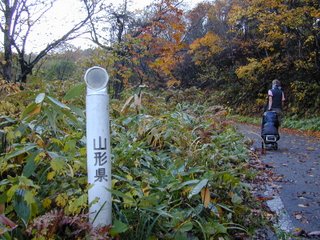
From: Kuroki
Date: Tue May 22 20:01:31 2001
出発おめでとおおう
北海道は予想以上に寒そうですね。
体力いちばん、無理せずがんばってください。
それにつけてもウニ丼のうらやましさよ。
これからも旅のレポート楽しみにしています!

From: kana
Date: Tue May 15 19:54:36 2001
よい旅を!
島袋さん、メアリーさん、こんにちは!
礼文島星観荘でお会いしました、利尻のバスガイドのムラカミです。
利尻での宿泊はYHだの、自然の家だの紹介させていただきましたが
全部アウトだったそうで、ゴメンナサイ。
どこに泊まられたのか、ちょっと心配・・・。
利尻島内で会えることを楽しみにしていたのですが
もう、稚内ですよね?
ワタシ自身、かつて徒歩の旅をしたことがあったので(北海道海岸線一周)
島袋さんとメアリーさんの、これから始まる旅のお話は
ほんとうに楽しくて、自分の旅のことみたいにわくわくしました。
与那国まで、いっぱいいっぱい楽しいことが起きそうですね!
道中クマに遭遇しませんことをお祈りしてます(笑)
気を付けてよい旅を!!!!!
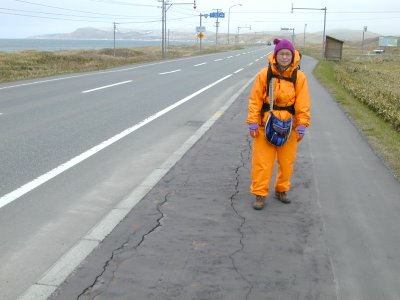
ALL PHOTOS BY JAPAN ON FOOT 2001/2002
To order photos click Here

From: スノーレッツ
Date: Sun May 13 23:27:01 2001
応援してます♪
メアリーさん、島袋さん、がんばってください。
応援してます。
近くを通るときは、直接応援したいです!
では、また。
